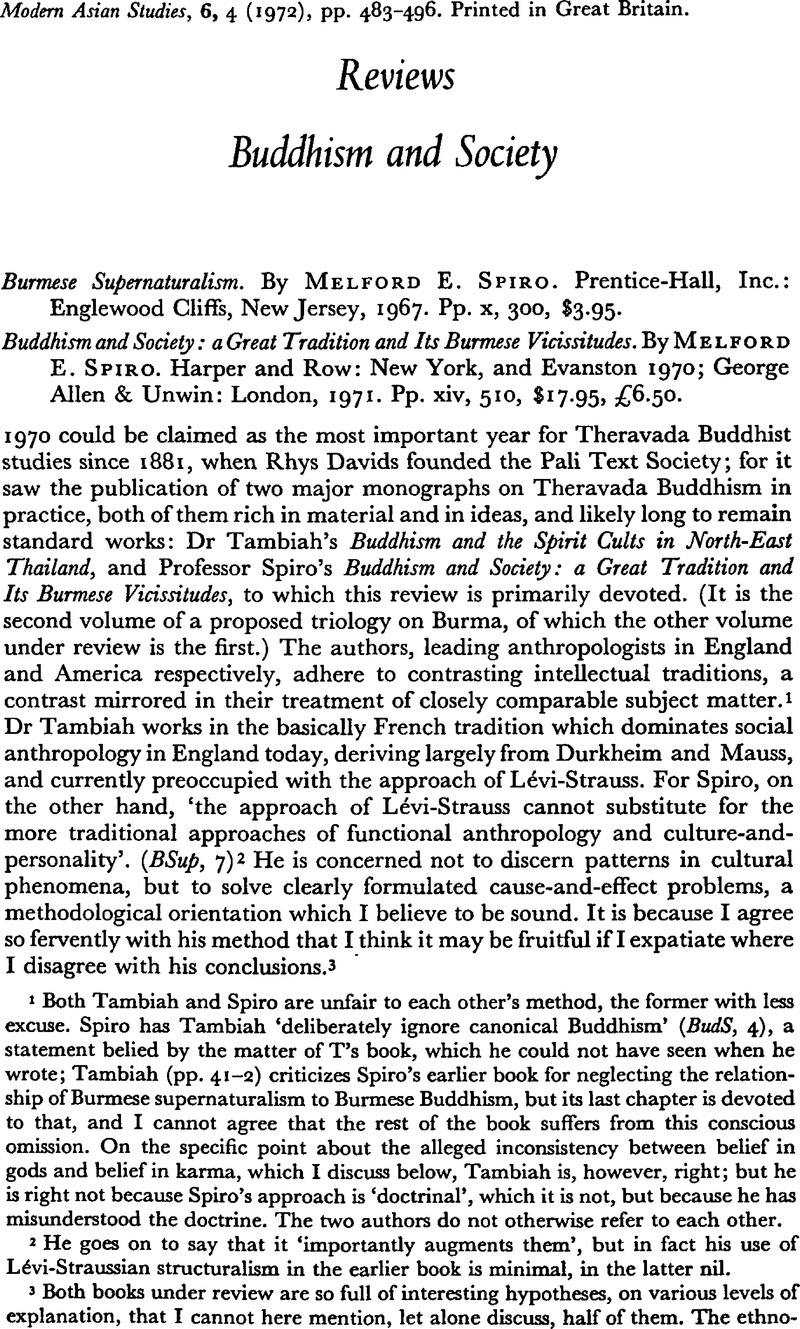Article contents
Buddhism and Society - Burmese Supernaturalism. By Melford E. Spiro. Prentice-Hall, Inc.: Englewood Cliffs, New Jersey, 1967. Pp. x, 300, $3.95. - Buddhism and Society: a Great Tradition and Its Burmese Vicissitudes. By Melford E. Spiro. Harper and Row: New York, and Evanston1970; George Allen & Unwin: London, 1971. Pp. xiv, 510, $17.95, £6.50.
Published online by Cambridge University Press: 28 November 2008
Abstract

- Type
- Reviews
- Information
- Copyright
- Copyright © Cambridge University Press 1972
References
1 Both Tambiah and Spiro are unfair to each other's method, the former with less excuse. Spiro has Tambiah ‘deliberately ignore canonical Buddhism’ (BudS, 4), a statement belied by the matter of T's book, which he could not have seen when he wrote; Tambiah (pp. 41–2) criticizes Spiro's earlier book for neglecting the relationship of Burmese supernaturalism to Burmese Buddhism, but its last chapter is devoted to that, and I cannot agree that the rest of the book suffers from this conscious omission. On the specific point about the alleged inconsistency between belief in gods and belief in karma, which I discuss below, Tambiah is, however, right; but he is right not because Spiro's approach is ‘doctrinal’, which it is not, but because he has misunderstood the doctrine. The two authors do not otherwise refer to each other.
2 He goes on to say that it ‘importantly augments them’, but in fact his use of Lévi-Straussian structuralism in the earlier book is minimal, in the latter nil.
3 Both books under review are so full of interesting hypotheses, on various levels of explanation, that I cannot here mention, let alone discuss, half of them. The ethnography I do not discuss because I have no independent knowledge of the facts. My qualifications for writing this review are an acquaintance with Pali Buddhist texts and detailed first-hand knowledge of Buddhism in central Ceylon.
4 ‘Religion: Problems in Definition and Explanation’, in Banton, M. (ed.), Anthropological Approaches to the Study of Religion, London, 1966.Google Scholar
5 As a hypothesis it goes much further than the ‘instrumental conception of ideas’ (BudS, 6), with which I fully agree.
6 Journal of Asian Studies, XXVIII, 4, 1969, 903.Google Scholar
7 ‘The Great Tradition and the Little in the Perspective of Sinhalese Buddhism’, Journal of Asian Studies, XXII, 2, 1963, 147–8.Google Scholar
8 For example: ‘After tasting the pleasures of the world and finding them wanting, a world-rejecting ideology becomes one viable alternative to what I take to be the modal mammalian orientation to the maximization of worldly pleasure. When a life which is successfully devoted to worldly pleasure is ultimately experienced as frustrating and (perhaps even more important) as meaningless, the renunciation of the social-cultural world can then be entertained as a desirable alternative.’ (BudS, 72) What would be lost by cutting from the first to the second ‘alternative’?
9 Thittila, U. in Morgan, Kenneth W., (ed.), The Path of the Buddha, New York, 1956.Google Scholar
10 See also Thomas, E. J., The History of Buddhist Thought, London, 1933, pp. 114–15.Google Scholar
11 Welbon, Guy Richard, The Buddhist Nirvana and its Western Interpreters, Chicago, 1967.Google Scholar
12 The fire which is ‘blown out’ is not that of life (p. 56), but craving.
- 1
- Cited by




